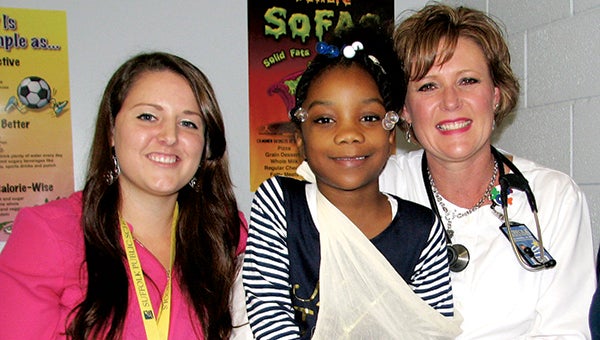‘Had to be an angel’
Published 6:36 pm Saturday, October 17, 2015

The family of Amaryana Harden, center, is crediting her second-grade teacher at Mack Benn Jr. Elementary School, Brittany Koman, left, and the school nurse, Stacy Breneman, right, with saving her life.
Teacher’s, nurse’s quick thinking saves girl’s life
There was a time, earlier this school year, when rookie teacher Brittany Koman wondered whether she was too quick to send students to the school nurse’s office when they complained of aches and pains.
But what happened in her classroom on Sept. 28 changed her whole way of thinking about the matter.
It was a hectic day in her second-grade class at Mack Benn Jr. Elementary School.
Koman, less than a month into her first year of teaching, was running around the classroom setting up computers for a test in reading.
“It was kind of a busy day,” Koman said. “I was all over the place.”
Reading is the favorite subject for Amaryana Harden, a 7-year-old with bright eyes and a gap-toothed smile that indicates a recent visit from the Tooth Fairy. So Koman was surprised when little Amaryana said her chest hurt.
“She said, ‘It hurts right here,’” Koman said. “She kept patting her chest.”
Koman thought it might be because Amaryana was worried about the test, even though she excels in reading. So she asked Amaryana to sit down and see if it went away.
But a couple of minutes later, it hadn’t gone away. Koman started filling out the form to refer Amaryana to the nurse.
After filling in Amaryana’s name, the date and other standard information, Koman got to the complaint section.
“That’s when it kind of really clicked,” Koman said. “This is chest pains.”
‘I knew something was not right’
Down at the nurse’s office, Stacy Breneman was having a fairly normal Monday, which typically consists of treating everything from scrapes and stomach viruses to assisting children with chronic medical conditions.
Breneman’s office is filled with fun posters emphasizing the importance of healthy eating and hand-washing. Her stethoscope, when not in use, lies next to an S-shaped notepad that has begotten plenty of S-shaped notes scattered the desk. Three cots provide a comfortable place to rest for sick students.
When Amaryana walked in with her referral, Breneman couldn’t tell anything was wrong.
“She was smiling just as beautiful as she is right now,” she said later.
Breneman read Koman’s note: Amaryana was complaining of chest pains and said it had been happening over the weekend.
Though Amaryana isn’t one of her usual asthma patients, Breneman thought that might be the problem. It’s a fairly common condition at her school and doesn’t always cause the wheezing people expect, she said.
But when she referred to Amaryana’s records, she saw no medical history whatsoever. She placed the stethoscope on Amaryana’s back, and the sound of her lungs was fine, Breneman said.
But then she decided to listen to Amaryana’s heart.
“As soon as I put my stethoscope on her chest, I knew something was not right,” Breneman said. “I heard what sounded like a murmur.”
The nurse timed Amaryana’s heart rate and discovered it was 48 beats per minute. A girl Amaryana’s age should have a heart rate between 80 and 100.
But Amaryana was still sitting there, smiling her gap-toothed smile.
“We’re trained to treat the patient, not the number,” Breneman said. Since Amaryana didn’t seem to be in distress, she called the girl’s mother, rather than an ambulance.
‘Her heart rate dropped to zero’
Keysha Harden had heard her daughter’s complaint of pain on the way to church the day before. But after church, Amaryana was still wrestling with her brothers like usual.
“It doesn’t hurt that bad, because you’re still playing,” Harden remembered thinking.
She told Breneman during the phone call that Amaryana had been diagnosed with a heart murmur at age 5, but their new pediatrician had recently said it was gone.
“I told mom, ‘I’m not comfortable,’” Breneman said. “I think you need to come and have her evaluated. If it’s nothing, great.”
But Breneman suspected it was something serious. And she was right.
Harden picked her daughter up from school and took her to Sentara Obici Hospital. The hospital staff took one look at the referral form and told Harden to take her to Children’s Hospital of the King’s Daughters in Norfolk.
But Harden was worried about being on the road with her daughter, who was still acting fine. What if she became not-fine on Interstate 264?
So she took Amaryana to Sentara BelleHarbour and got the same response. “Take her to King’s Daughters.”
By the time they arrived at CHKD, Amaryana’s heart rate had plummeted to 26 beats per minute. Nurses hooked up a heart monitor, and Harden couldn’t take her eyes off the awful countdown. 22. Then 19. Up into the 50s, if somebody made her laugh, but then back down.
“On Tuesday night, her heart rate dropped to zero,” Harden said. “It never affected her.”
By that point, doctors had determined one side of Amaryana’s heart was enlarged. They couldn’t figure out why, but their recommendation to Harden was to cut into her 7-year-old and install a pacemaker.
Harden was horrified at the thought of her second-grader needing a pacemaker. But she assented.
“Anything that’s going to save my daughter, just do it,” she told them.
‘It had to be an angel’
The surgery dragged on while the Harden family waited. Four hours. Then five. Then six.
After nine long hours, the doctor finally emerged. He had found the problem with Amaryana’s heart. It has no nerves in the top two chambers, so he had to install the pacemaker’s leads into a different place in the heart, where they would have some nerves to stimulate.
Harden questioned what happened to cause the problem and how her daughter had survived seven years with such a malfunction in her heart.
“I don’t know” was the answer from the doctor on both counts. “We’ll probably never know.”
The doctor also said the condition, while serious, probably wouldn’t have caused Amaryana’s chest pains. That leaves yet another unknown: How did Amaryana know something was wrong?
“It had to be an angel,” Harden said. “This baby is a miracle baby.”
‘Who knows what could have happened?’
Amaryana returned to school on Oct. 12, wearing her left arm in a sling to keep it off the incision on her side and to serve as a visual reminder to other students not to bump into her.
Classmates had plenty of questions. Did you break your arm? What was it like to have surgery? Amaryana answered them all with pride.
And the adults in her life couldn’t be happier at the outcome.
“I’m just so appreciative of both of them,” Harden said. “I just applaud Ms. Koman for listening to my daughter, and then I’ve never seen a nurse that goes so above and beyond. It’s amazing how two people can work together to save this baby’s life.”
Koman said she had just talked with Breneman shortly before Amaryana’s complaint, concerned that she was sending too many students to the nurse. But Breneman had reassured her.
“You have to follow your gut,” Breneman says. “When children are persistent like that, their body is telling them something’s not right. Who knows what could have happened?”





